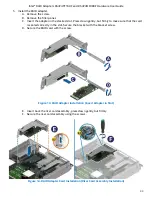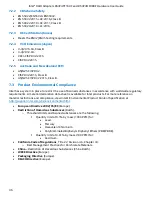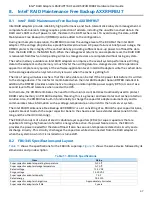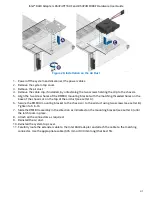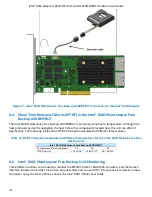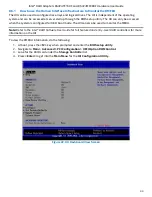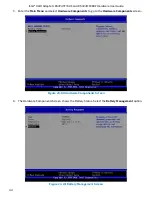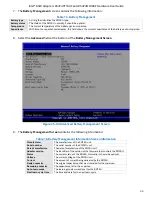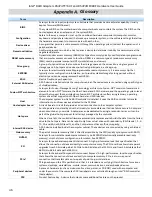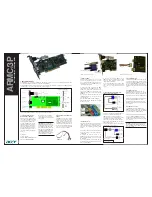
Intel® RAID Adapters RS3P4TF160F and RS3P4MF088F Hardware User Guide
47
Term
Description
PHY
The interface required to transmit and receive data packets transferred across the serial bus.
Each PHY can form one side of the physical link in a connection with a PHY on a different SAS device.
The physical link contains four wires that form two differential signal pairs.
One differential pair transmits signals, while the other differential pair receives signals. Both
differential pairs operate simultaneously and allow concurrent data transmission in both, the receive
and the transmit directions.
RAID
Acronym for redundant array of independent disks (originally Redundant Array of Inexpensive Disks).
An array (group) of multiple independent drives managed together to yield higher reliability,
performance, or both exceeding that of a single drive.
The RAID array appears to the controller as a single storage unit. I/O is expedited because several
drives can be accessed simultaneously. Redundant RAID levels (RAID levels 1, 5, 6, 10, 50, and 60)
provide data protection.
RAID levels
A set of techniques applied to drive groups to deliver higher data availability, performance
characteristics, or both to host environments. Each virtual drive must have a RAID level assigned to it.
RMFBU
Refers to the Intel® Maintenance Free Backup Unit AXXRMFBU7 accessory kit.
SAS
Acronym for Serial Attached SCSI. A serial, point-to-point, enterprise-level device interface that
leverages the proven SCSI protocol set.
The SAS interface provides improved performance, simplified cabling, smaller connections, lower pin
count, and lower power requirements when compared to parallel SCSI. SAS controllers leverage a
common electrical and physical connection interface that is compatible with Serial ATA.
The SAS controllers support the ANSI
Serial Attached SCSI Standard, Version 2.0
. In addition, the
controller supports the Serial ATA III (SATA III) protocol defined by the
Serial ATA Specification, Version
3.0
.
Supporting both the SAS interface and the SATA III interface, the SAS controller is a versatile controller
that provides the backbone of both server and high-end workstation environments. Each port on the
SAS RAID controller supports SAS devices, SATA devices, or both.
SAS device
Any device that conforms to the SAS standard and is attached to the SAS bus by a SAS cable. This
includes SAS RAID controllers (host adapters) and SAS peripherals.
SATA
Acronym for Serial Advanced Technology Attachment. A physical storage interface standard, SATA is a
serial link that provides point-to-point connections between devices. The thinner serial cables allow
for better airflow within the system and permit smaller chassis designs.
SMART
Self-monitoring analysis and reporting technology.
SRIS
Separate Reference Clock with Independent Spread. Refers to a PCIe device using an independent
clock signal.
SSP
Acronym for Serial SCSI Protocol. SSP enables communication with other SAS devices. Each PHY on
the SAS controller can function as an SSP initiator.
STP
SATA Tunneling Protocol. Protocol to allow SATA communication through SAS expanders.
StorCLI
Command line software tool to manage RAID hardware, physical and virtual drives.
Stripe
The portion of a stripe that resides on a single drive.
Stripe size
The total drive space consumed by a stripe not including a parity drive. For example, if a stripe
contains 64 KB of drive space and has 16 KB of data residing on each drive, the stripe size is 64 KB and
the strip size is 16 KB.
A larger stripe size produces improved read performance, especially if most of the reads are
sequential. For mostly random reads, select a smaller stripe size.
Striping
Drive striping writes data across two or more drives. Each stripe spans two or more drives but
consumes only a portion of each drive. Each drive, therefore, may have several stripes. The amount of
space consumed by a stripe is the same on each drive that is included in the stripe.
The portion of a stripe that resides on a single drive is a strip, also known as a stripe element. Striping
by itself does not provide data redundancy; striping in combination with parity provides data
redundancy.
Strip size
The drive space consumed by a strip. For example, if a stripe contains 64 KB of drive space and has 16
KB of data residing on each drive, the stripe size is 64 KB and the strip size is 16 KB. The stripe depth is
four (four drives in the stripe).

